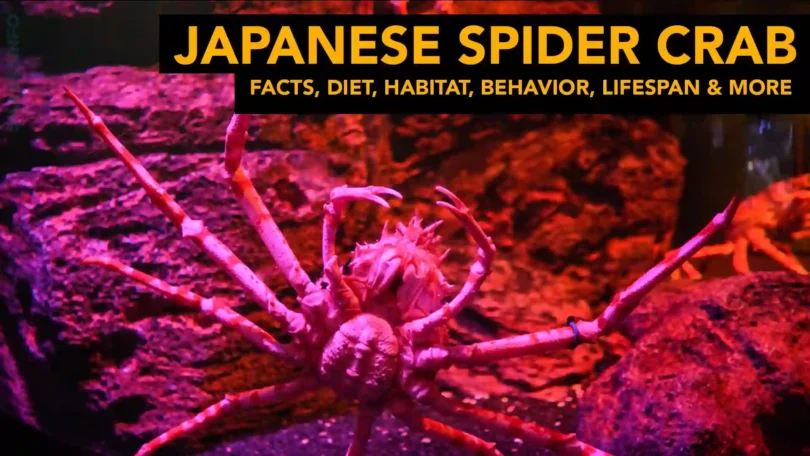Japanese spider crabs are the largest of the 60,000 crustaceans on the planet, reaching lengths of up to 12.5 feet from the tip of one front claw to the other. They are also one of the world’s largest arthropods, which are animals that lack a backbone, have external skeletons, and have multiple-jointed limbs. In the case of this crab, the appendages are its ten legs. Here is a detailed guide about these crabs and their general characteristics.
Japanese Spider Crab- Facts
Scientific name: Macrocheira kaempferi
Taxonomic Classification
| Kingdom | Animalia |
| Phylum | Arthropoda |
| Class | Malacostraca |
| Order | Decapoda |
| Family | Inachidae |
| Genus | Macrocheira |
| Species | kaempferi |
Physical Attributes
Their mottled orange-and-white bodies, cream-colored undersides, and spiky, oval carapaces mix in with the rocks on the ocean floor in these waters. Japanese spider crabs have arachnid-like shells and lengthy legs, hence their popular name.

Spines are also found behind and in front of these creatures’ short-eye stalks. Males are larger than females and have larger chelipeds, or claw-holding legs, while females have wider abdomens to hold their eggs.
Size And Weight
A significant catch for any fisherman is the Japanese spider crab. It is the largest crab, with a leg span of 13 feet (4 meters) and an average weight of 40 pounds (16-20 kg).
Habitat
The Japanese Spider crab can be found in the Pacific Ocean near Japan. It lives on the seafloor, often in vents and holes at depths of 160 to 2,000 feet (50-600 m), and their bodies let them blend very well with the ocean floor. They flourish at temperatures around 50°F.

Diet
Japanese spider crabs are slow-moving organisms that like to feed on the dead and decaying matter of animals and plants along with living crustaceans, plants, algae, and sometimes small fish as well.

Reproduction And Lifespan
Japanese spider crabs migrate to the shallower end of their depth range during mating season, which lasts from January to April. Internal fertilization happens when a spermatophore, or sperm packet, is inserted into the female while their abdomens push together. The fertilized eggs are carried in the female’s abdomen, often known as the apron.

Females produce about a million eggs, each measuring about.03 inches in length, and these huge organisms begin as small as they can. Few will hatch, but those that do will emerge after around 10 days without parental care. Approximately nine to twelve days after hatching, they molt for the first time.
It has the longest longevity of any crab, reaching the age of 100.
Conservation Status
Japanese spider crabs have not been studied by the IUCN, and they are not officially categorized as an endangered species. However, numbers have been reported to be declining due to overfishing and environmental destruction.

The Bottom Line
Japanese spider crabs have orange-mottled bodies, resembling the bodies of spiders, and are known as one of the largest crabs. They are slow-moving organisms thus they do not spend a lot of energy on catching prey but consume what’s readily available. Their conservation status is unknown but a decline in their number shall be taken seriously. That’s all from today’s sharksinfo.com tutorial about Japanese spider crab; facts, diet, habitat, behavior, and lifespan.







